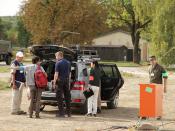Collaboration on Control MechanismThrough discussion and collaboration of ideas, Team D came up with a concrete summary of control mechanisms and their purpose to an organization. In the following essay, four types of control mechanisms are shown. Further, we have compared and contrasted these mechanisms, demonstrating the effectiveness and effect of controls, and describing how these controls affect the four functions of management.
In a modern organization, there are four areas where controls can be implemented to maximize productivity with a given amount of available resources. As lectured by Paul Moore, Professor of the University of Phoenix, the four areas of control are people, information, physical resources, and financial. Within these areas certain mechanisms can be applied to each area. As described in Management: Leading & Collaborating in a Competitive World, control is "a means or mechanism for regulating the behavior of organization members."(Bateman, pg.2). These four mechanisms are the most commonly used and familiar to our group member's current work environment.
Bureaucratic Control, Market Control, Clan Control and Budgetary Control, are some of the most common and implemented types of controls. Also, these controls are typically used together simultaneously within and throughout the same organization.
Bureaucratic Control is by far the most common type of control and is second nature to most companies. This control is necessary because it establishes rules and order in an organization. It also encourages employees to stay on track by providing protocol for every worker as a reference. Recently, employees have resisted this type of control because they refuse to be treated like machines. Often, Bureaucratic Organizations will have at least one of the following responses: rigid, tactical, or resistant. Organizations that are too bureaucratic tend to lack interpersonal relations and customer satisfaction due to overly regulated activities. This is one downfall of Bureaucratic Control, which has caused many companies to rebuild their organizations. These views are shared by Monique who worked for AT&T, and Bill who works for the United States Postal Service. Although Bureaucratic control is the oldest and most common form of control, businesses are finding this type to be less effective than others.
Market Control is used to monitor employees by their productivity through economic transactions. This type treats the majority of the business as a profit center with gains and losses. Managers are evaluated upon these results. The purpose of this is to economize, account for, and streamline work. It also serves to diminish wasted time and apply more resources to activities that create revenue returns. Market Control brings out the visibility of the value of goods and services by employees and departments. The benefit of this is that after the assessment is done, future transactions can be based off of this, and there can be goals set to lower the price and maximize the output of services. Market Control has become more common in today's industries due to its visibility of current standings, making it easier for companies to set goals and plans and track the progress of productivity.
Clan Control has emerged as a necessity, where it is utilized outside of the standard bureaucratic system. Clan Control is based on the concept that if employees share the same values, expectations, and goals, they will be more likely to govern themselves in accordance with the organization. Bateman states in the text, Management: Leading & Collaborating in a Competitive World, that "when members of an organization have common values and goals-and trust one another - formal control may be less necessary" (Bateman, pg.4). As a Specialist in the National Guard, I'm familiar with this concept. Many of our training programs and exercises are based on this ideology. We are expected to build a cohesive environment, where every soldier wants to independently succeed in the unit because it defines his or her own success. Clan Control is an effective control, but from my own experiences it is often implemented with Bureaucratic and Market Control to provide structure and a means to quantitatively measure achievements.
These controls not only affect the four functions of management, but are a necessity to perform these functions effectively. The first function of management is the planning function. To do this effectively, you need to use available resources, such as, prior responses within other organizations that have been successes or failures. This is an example of using previous information through environmental scanning. Use of this information might guide you on how to plan and what to expect if you use certain types of Control Mechanisms in your planning. The same can be said about the other functions of leading, organizing and controlling. Part of being an effective manager is being able to adapt to different situations and still be successful. As a team, we feel that the most effective managers arm themselves with as much data and information as possible, have firm knowledge and understanding of controls that provide positive responses, and also being aware of the controls that provide negative responses. Understanding these concepts will help managers avoid pitfalls in productivity and the demoralization of employees.
ReferencesBateman, T. S., & Snell, S. A. (2009). Management: Leading & Collaborating in a Competitive World (8th ed.). New York: McGraw-Hill.




